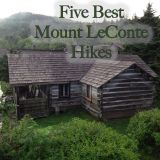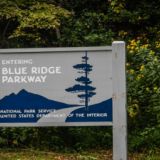Smoky Mountain grist mills. Mountain streams and rivers provided water power for early grist mills. The fast-moving creeks of the Great Smoky Mountains proved perfect sites for grist mills which were often the gathering place for early pioneers who traveled miles over winding mountain roads and trails to get corn and wheat ground by the great mill stones. Corn was possibly the settler’s most important crop and one of its greatest virtues was that it could by crushed into coarse meal. Corn could be planted on uncleared land and an acre, which provided up to 20 times the yield as an acre of wheat, was a source of food for both the family and farm animals. Corn had a variety of other uses for early residents. Men and women enjoyed smoking ground shuck in corncob pipes; corn shuck was used to stuff mattresses and to make children’s dolls. It was also found in outhouses (we will leave that to your imagination.)
You can still purchase buhr (stone) ground cornmeal today at several of the active grist mills that remain in the Great Smoky Mountains National Park.
John P. Cable Mill in Cades Cove is perhaps one of the most popular and picturesque mills in the Smoky’s. Cable built his mill in the early 1870s along Mill Creek and dug a connecting channel to Forge Creek to insure against times of drought. A low dam directs water from the upper end of a millrace and several water gates allow the regulation of flow. The last water gate is operated by a long lever located inside the mill. The water from the millrace meets the flume and is channeled through a chunk rack which acts as a giant wooden comb preventing debris from entering the 235 foot flume that slopes slightly downward before veering towards the mill and the eleven-foot high overshot waterwheel rising vertically alongside. Water from the flume fills the wheel’s 40-plus buckets- turning the huge wheel and driving a shaft that propels the millstones inside.
Cable considered milling a part time job and his mill had specific hours and days but unexpected arrivals could ring a large bell, located adjacent to the business, to summon Cable from his nearby fields.
Cable’s Mill is located about midway on the road in Cade’s Cove. In addition to the mill, the site also features a vintage farmhouse, barns and outbuildings. During the season, volunteer millers are often on hand to demonstrate the art of grinding grain. The finished products are sold in the park store also located on the property.
Mingus Mill, on its original site, is a scant half mile north of the Oconaluftee Visitor Center in Cherokee on U.S. 441. Built in 1886, the mill uses a water powered turbine instead of a water wheel to activate the machinery in the building. Water flows down a millrace to the mill where a working cast iron turbine turns the heavy millstone. An onsite miller demonstrates the process of grinding kernels into cornmeal which is offered for sale, along with other mill items. The grounds are open daily. The miller’s hours are 9 a.m.-5 p.m. mid-March through mid-December. It is also open Thanksgiving weekend.
Alfred Reagan House and Tub Mill, circa 1900, is one of the best places to imagine just how isolated life in the Smoky’s was for early settlers. Densely forested high ridges surround the narrow valley which is home to the Roaring Fork River- the mill’s source of power. Beyond the sound of rushing water are silence, solitude, and many say a profound sense of loneliness. Nearby, almost perpendicular, overgrown fields where corn was once planted, bear witness to the labor intensive business of farming in these rugged mountains. Reagan’s tub mill, one of the most common types of mills in these mountains, utilized wooden channels to carry water to a primitive horizontal wooden turbine wheel which turned and provided direct drive power to the mill’s stones. A small tub mill could produce about a bushel of cornmeal a day.

The Alfred Reagan tub mill in the Cherokee Orchard is a great stop on this scenic drive.
A short walk off Cherokee Orchard road, past rock walls that bordered long forgotten pastures, leads to the Ogle Mill, located on the Noah “Bud” Ogle (1863-1913) farmstead which included a house, barn and a “weaner” cabin for any newlywed offspring. The rough-cut tub mill, built in the 1880s near LeConte Creek, relies on hollowed-out logs that serve as a flume to divert water to the mill. The 22-inch millstones, used in grinding the kernels, would take a craftsman almost a week to perfect. This work included sharpening grooves and lands (raised strips between the grooves) to ensure that all the grains were crushed during the milling process. The mill was restored to operational condition in the 1960s. Ogle Mill is located about a half-mile from the cabin and barn. Cherokee Orchard Road, a scenic one-way road connects the Ogle place to U.S. route 441 in downtown Gatlinburg to the north and to the roaring Fork Motor Nature Trail to the south.
Cornmeal, a humble substance with both Native American and African roots, has been used for centuries by colonists, enslaved people, and moonshiners (perhaps the happiest of all consumers.) Lately it is enjoying an upscale revival by noted chefs who research the different types of meal in order to provide a gourmet experience.
The humble rustic product provides a delicious bread known by a variety of names; Johnnycakes, spoon bread, spider bread and corn meal mush, (legend has it that this was a favorite of George Washington because it was easy to eat with his false teeth.) A coarser grind is used for grits- a perennial southern breakfast food.
Whether you prefer yellow or white, coarse ground or fine, with or without sugar, no respectable meal south of the Mason-Dixon Line is complete without one or more of these dishes. Cornmeal also has its share of Yankee fans. Rhode Island lays claim to Johnnycakes and Bostonians love their brown bread.
Recipe for cornbread
11/2 cups stone ground cornmeal
3 Tbsp. flour
11/4 tsp. baking powder
1 tsp. salt
¼ tsp. baking soda
1 tsp. sugar
11/2 cups buttermilk
1 large egg (slightly beaten)
2 Tbsp. melted butter
Cooking spray for skillet.
Pre-heat oven to 425 degrees and place a10-inch, well-seasoned cast iron skillet inside.
Combine all dry ingredients in a large bowl. Add buttermilk and egg stirring to form a thick soupy batter, and then stir in the melted butter. Lightly coat HOT skillet with cooking spray and pour in batter. Bake for about 20 minutes until browned.
Culinary bonus tip: For a fancier version add any of these: grated cheese, jalapeno peppers, bacon, corn kernels or sundried tomatoes.
Related













